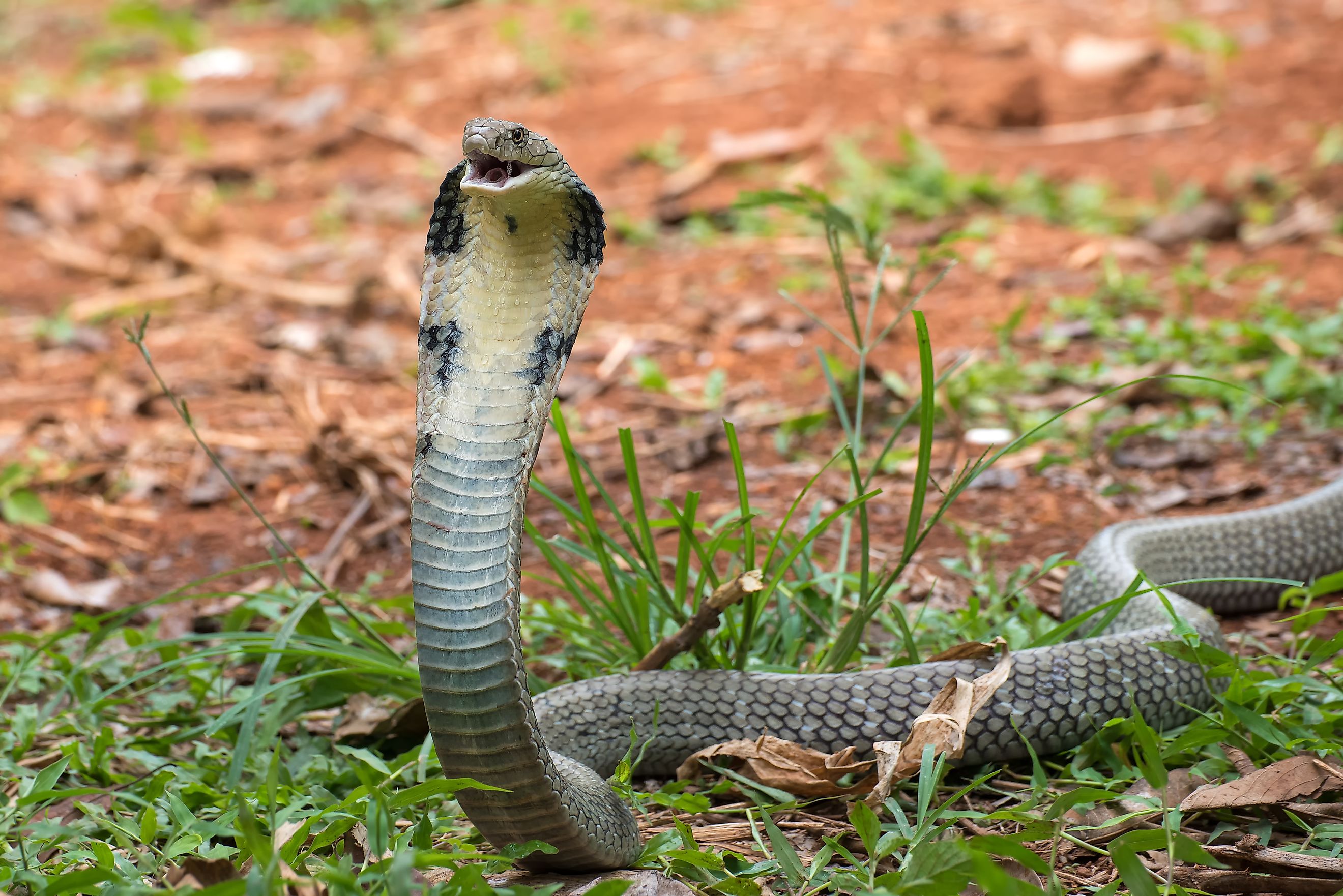
10 of the Fastest Snakes in the World
Snakes, one of the animal kingdom’s most interesting reptiles, are known for their potent venom, unique hunting techniques, and beautiful scales. However, many overlook the speed and agility that snakes rely on for hunting and evading predators. Some of the world's fastest snakes have developed adaptations that enable them to move swiftly through various terrains, from deserts to forests. These reptiles showcase the diversity and specialization that evolution can produce, highlighting how different species can achieve speeds to meet their environmental challenges. Let’s take a look at the top 10 fastest snakes in the world.
Sidewinder (Crotalus cerastes) - 18 mph (29 kph)
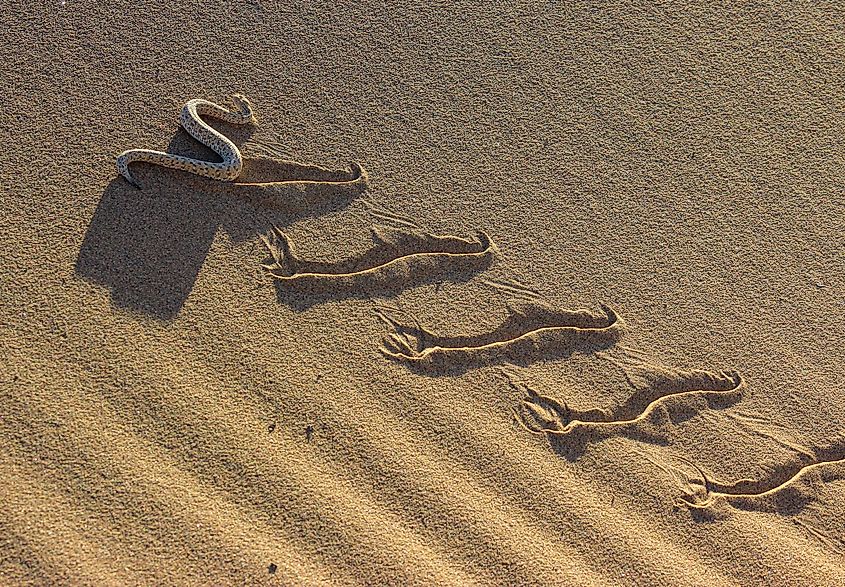
The Sidewinder, also known as the horned rattlesnake, inhabits the deserts of the Southwestern United States and Northwestern Mexico. It has a distinct appearance, with keeled scales and horn-like projections above its eyes. The body is usually pale brown, tan, or gray to camouflage against the sandy desert terrain. Sidewinders are adapted to a desert lifestyle, often found in areas with loose, sandy soils where they can bury themselves to avoid extreme temperatures.
The Sidewinder can move at speeds up to 18 mph (29 kph) thanks to a unique method of locomotion. This method involves lifting parts of its body off the ground, creating a series of S-shaped curves that allow it to move rapidly across loose sand. This snake uses its speed to escape predators and to ambush prey, primarily small mammals, lizards, and birds. The Sidewinder's venom is potent, causing tissue damage and bleeding in its victims. While not typically aggressive, it will bite if threatened or provoked.
Black Mamba (Dendroaspis polylepis) - 12 mph - (19 kph)
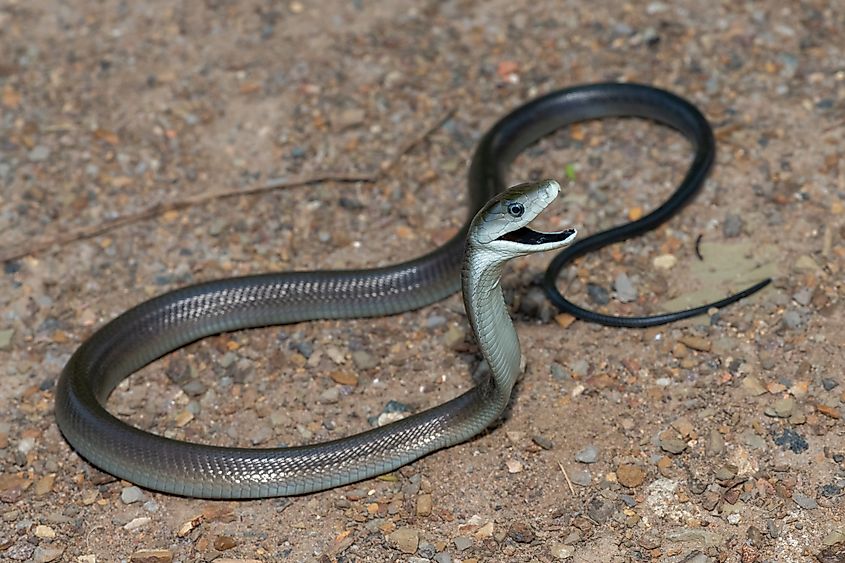
The Black Mamba is found in various habitats across Sub-Saharan Africa, including savannas, rocky hills, and open woodlands. It is one of the longest venomous snakes, reaching lengths of up to 15 feet. Its coloration ranges from gray to dark brown, with a lighter underside. The name "Black Mamba" comes from the blue-black color of the inside of its mouth, which it displays when threatened. This snake is highly agile and has a slender, streamlined body.
The black mamba is one of the fastest land snakes, capable of reaching speeds up to 12 mph (19 kph). It uses its speed to escape threats and to hunt small mammals and birds. The Black Mamba is highly venomous, with a bite that can deliver a fatal dose of neurotoxins. It is known for its aggressive behavior when cornered or threatened. Despite its fearsome reputation, the Black Mamba prefers to avoid confrontation and will flee from danger if possible.
Eastern Brown Snake (Pseudonaja textilis) - 12 mph - (19 kph)
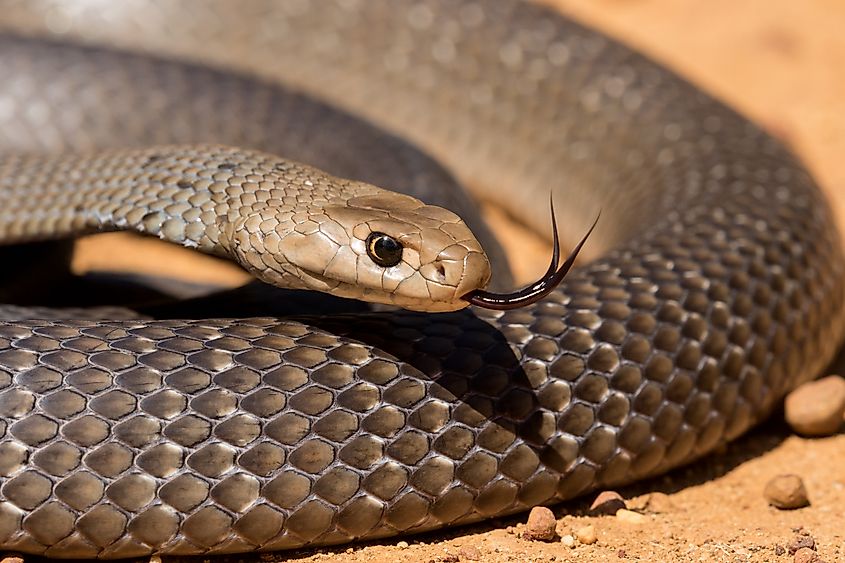
The Eastern Brown Snake is native to Eastern and Central Australia and is commonly found in forests, woodlands, grasslands, and urban areas. It has a slender body with smooth scales and can grow up to 7 feet in length. Its coloration varies from pale brown to almost black, and it often has darker markings on the head and neck. This snake is highly adaptable and often encountered in areas with abundant rodent populations.
Eastern Brown Snakes can reach up to 12 mph (19 kph) in speed. They use their speed to chase down prey, primarily small mammals, birds, and reptiles. This species is highly venomous, with a bite containing neurotoxins and coagulants that can cause rapid and severe symptoms in humans. Although generally shy and preferring to flee, the Eastern Brown Snake can become aggressive if threatened, making it one of the most dangerous snakes in Australia.
King Cobra (Ophiophagus hannah) - 12 mph - (19 kph)
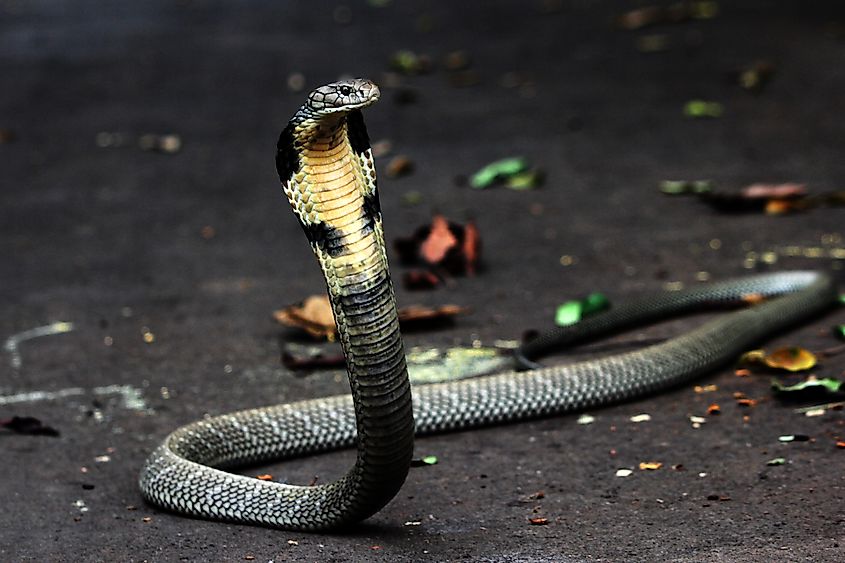
The King Cobra inhabits forests, bamboo thickets, and agricultural areas in Southeast Asia and India. It is the world's longest venomous snake, with adults reaching up to 18 feet in length. The King Cobra has a distinctive hood, which it flares when threatened, and its coloration can range from olive green to black with pale yellow crossbands. It has a keen sense of sight and can detect movement up to 330 feet away.
King Cobras are fast, moving at speeds up to 12 mph (19 kph). This speed allows them to escape threats and pursue prey, which includes other snakes, lizards, and small mammals. The King Cobra's venom is neurotoxic, affecting the nervous system and causing respiratory failure in severe cases. Despite their fearsome reputation, King Cobras are generally shy and avoid humans, but they will defend themselves aggressively if provoked.
Cottonmouth Viper (Agkistrodon piscivorus) - 7 mph - (11 kph)

The Cottonmouth Viper, also known as the water moccasin, is native to the Southeastern United States and is found in wetlands, swamps, and along rivers and lakes. It has a thick, muscular body with a dark, often banded coloration and a distinctive white lining in its mouth, which it displays when threatened. Cottonmouths are semi-aquatic and are proficient swimmers, often seen basking on logs or rocks near water.
Cottonmouth Vipers can slither up to 7 mph (11 kph) and are especially agile in water. Thanks to this, they are efficient at both hunting and avoiding predators in and around water bodies. Unlike many other snakes on this list, Cottonmouth Viper bites are rarely fatal to humans. However, their venom is hemotoxic, causing tissue damage and disrupting blood clotting, so it is best to run away if one is chasing after you.
Texas Rat Snake (Elaphe obsoleta lindheimeri) - 6 mph - (10 kph)
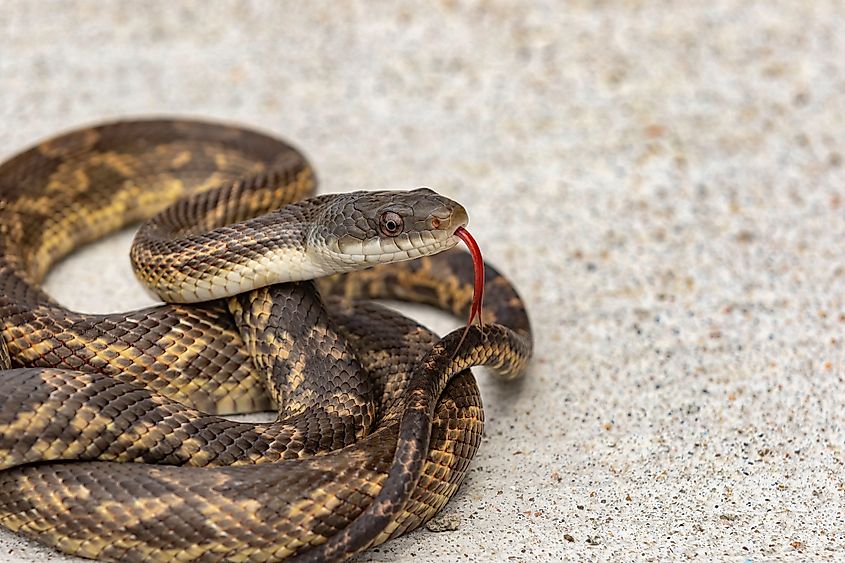
The Texas Rat Snake is a non-venomous species that belongs to Texas and neighboring states. It inhabits forests, grasslands, and urban areas, often found near farms and buildings where rodents are plentiful. This snake can grow up to 6 feet long and has a variable coloration, typically featuring a pattern of gray, brown, and black markings on a lighter background. It is known for its climbing ability and often seeks refuge in trees or buildings.
These snakes are capable of moving swiftly at approximately 6 mph (10 kph). They leverage their speed and agility to catch prey such as rodents, birds, and eggs. To this end, they play a vital role in controlling rodent populations and benefit the ecosystems they inhabit. Although they move quickly, Texas Rat Snakes are non-venomous and pose no threat to humans.
Coachwhip (Masticophis flagellum) - 4 mph - (6 kph)
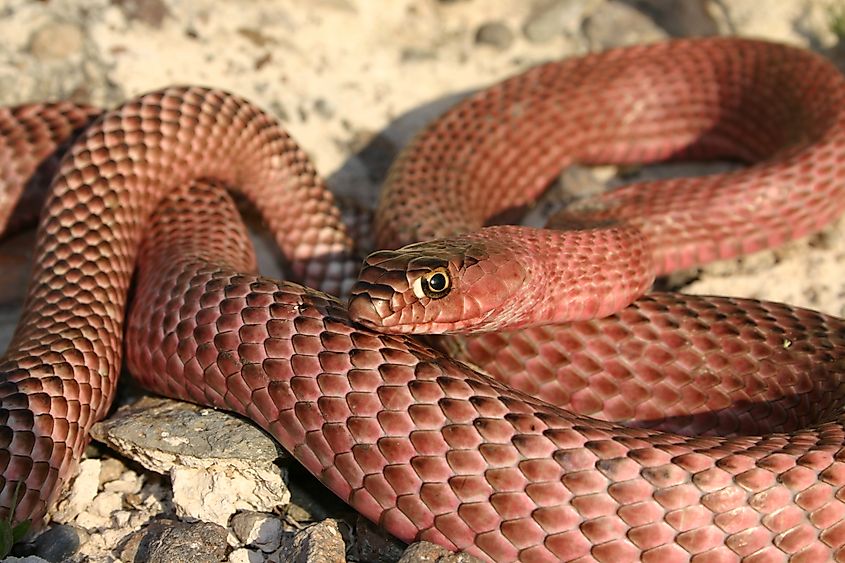
The Coachwhip is a slender, fast-moving snake found in the southern United States, Mexico, and Central America. It prefers open habitats such as deserts, grasslands, and scrublands. This snake can grow up to 8 feet in length and has a distinctive coloration that resembles a braided whip, with a dark head and lighter, tan to reddish body.
Coachwhips can accelerate up to 4 mph (6 kph), which, combined with their keen eyesight and active hunting behavior, makes them a formidable predator. Thus, the snake can hunt down an array of small animals, including lizards, small mammals, birds, and insects. Although non-venomous, Coachwhips are defensive and may strike repeatedly if threatened. Thankfully, their first instinct is often to flee with the aid of their quick pace.
Southern Black Racer (Coluber constrictor priapus) - 4 mph - (6 kph)
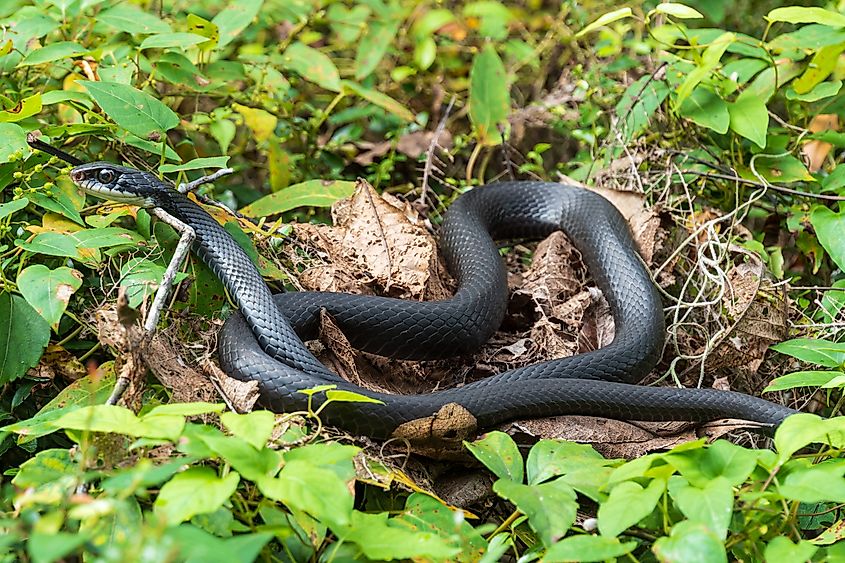
The Southern Black Racer is commonly found in the southeastern United States, inhabiting forests, fields, wetlands, and suburban areas. It has a sleek, black body with a white chin and can grow up to 5 feet long. Black Racers are diurnal and are often seen actively hunting during the day. They are excellent climbers and swimmers, adapting well to various environments.
Southern Black Racers can reach speeds of up to 4 mph (6 kph). Their quickness aids them in escaping predators and hunting a variety of prey, including insects, frogs, lizards, small mammals, and birds. When threatened, they may vibrate their tails and strike repeatedly, but their bites will do no serious harm to humans. Along with this, they are beneficial to ecosystems by controlling pest populations.
Western Yellow-Bellied Racer (Coluber constrictor mormon) - 4 mph - (6 kph)
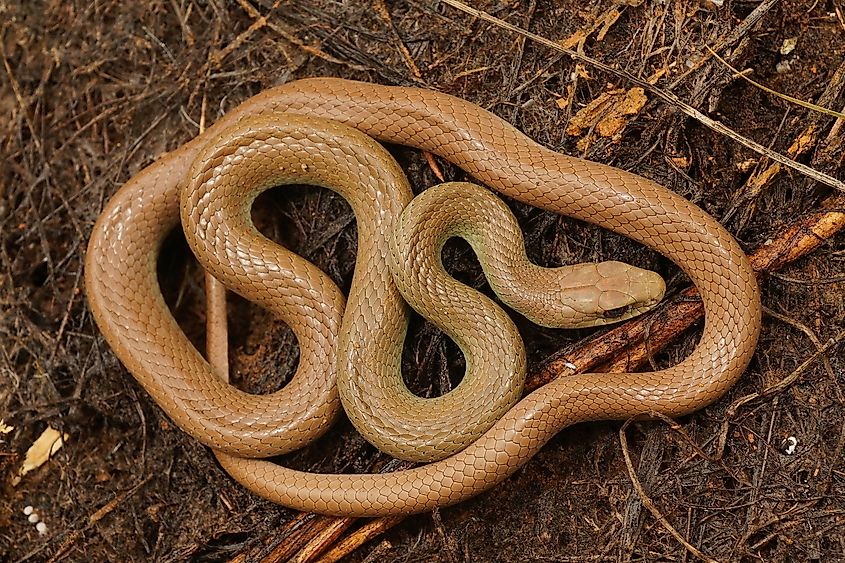
The Western Yellow-Bellied Racer is found in the Western United States, inhabiting grasslands, forests, and shrublands. It has a slender body with a distinctive yellow or greenish-yellow underside and can grow up to 6 feet in length. This snake is active during the day and is known for its speed and agility. Western Yellow-Bellied Racers can travel at speeds reaching 4 mph (6 kph). Using its speed, the snake will often climb trees and shrubs in search of prey. Thus, they are efficient hunters and often prey on small birds along with land mammals. These snakes are non-venomous and pose no threat to humans. When threatened, they may flee quickly or exhibit defensive behaviors such as striking and vibrating their tails.
Boomslang (Dispholidus typus) - 4 mph - (6 kph)
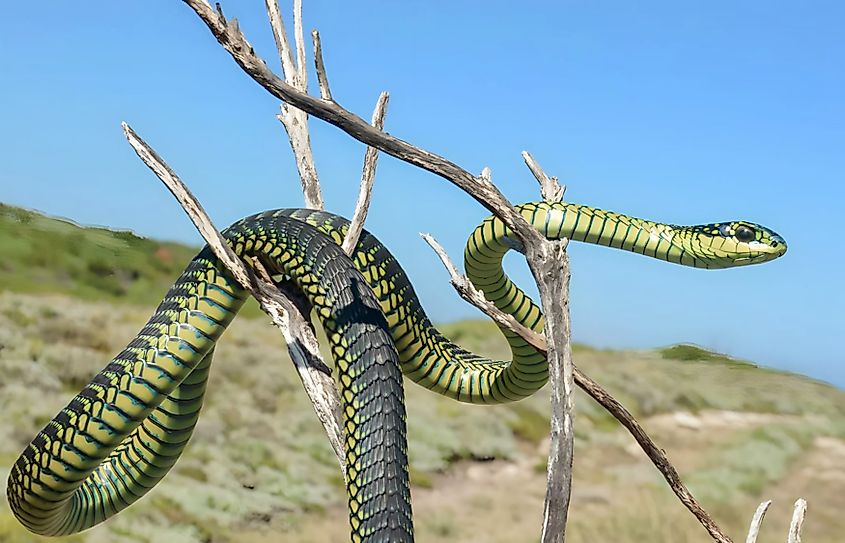
The Boomslang is native to Sub-Saharan Africa and is primarily found in woodlands, savannas, and forests. It has a slender body with large eyes and an elongated head and can grow up to 6 feet in length. The coloration varies, with males typically bright green and females brown or olive. Boomslangs are arboreal and spend much of their time in trees, using their excellent vision to hunt for prey.
Boomslangs navigate their environments at speeds up to 4 mph (6 kph), making them one of the fastest snakes in the world. They rely on their agility to move through the trees and capture prey, including birds, eggs, lizards, and small mammals. Boomslangs are highly venomous, with hemotoxic venom that disrupts blood clotting. Despite their potent venom, they are shy and generally avoid human contact. Most bites occur when humans attempt to handle or provoke the snake, but fatalities are rare with prompt medical treatment.
In Summary
The ten fastest snakes on Earth are a testament to the adaptations and survival strategies shaped by evolution. From the Sidewinder in the desert to the Boomslang in trees, each species has developed capabilities that enable it to thrive in specific habitats. The rapid movement of these snakes is a direct outcome of evolutionary pressures that have shaped their behaviors and physical traits over time.











